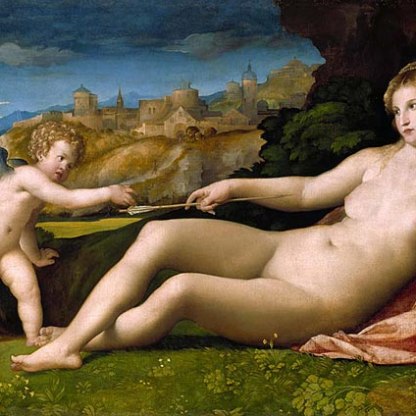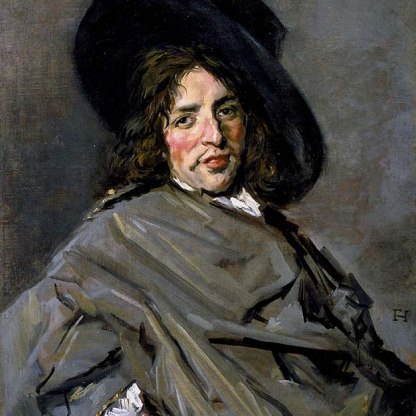Tarquin and Lucretia

Because I desire to close the days of this my extreme old age in the service of the Catholic king, my Lord, I promise you that I am composing another invention of painting of much greater labor and ingenuity than perhaps any I have produced for many years until now...
These words, written by Titian to his patron Philip II of Spain in 1568, refer to this dramatic canvas, one of two large paintings by the great Venetian artist in the Fitzwilliam. Titian was over eighty by the time Tarquin and Lucretia was completed, which makes the work's sheer vitality all the more remarkable. For this is not the work of a frail old man, but that of a vigorous storyteller, a visual poet at the height of his powers.
The subject is the rape of Lucretia, the chaste wife of a Roman nobleman, by Sextus Tarquinius, a sixth-century BCE Roman prince. The unsettling combination of violence and beauty makes it an extraordinarily moving and involving image.
There is no ignoring the brutality of Tarquin's act here. The tip of his tightly gripped dagger conspicuously catches the light. His sturdy, naked knee has broken free of its breeches and thrusts itself between Lucretia's splayed legs. He leans into her with all his ample weight, his left foot only just touching the ground. Titian suggests a tremendous sense of motion within the scene, with the swirling green curtain at the back and the almost blurred effect of much of the brushwork.
Meanwhile the look of surprise and terror on Lucretia's face is unmistakeable. Small, bright tears glisten on her cheek. Certain Christian writers condemned Lucretia for allowing herself to be raped. Titian seems unambiguous about her innocence.
But Titian's Lucretia is emphatically voluptuous as well as vulnerable. Blonde and bejewelled, her body is as soft and sensuous as that of Venus, the goddess of love, in the Fitzwilliam's other painting by the artist [129]. Titian brilliantly conveys the quality that has inflamed Tarquin whilst at the same time condemning him. Is the viewer somehow implicated in the crime, like the figure who gazes on from behind the curtain, unable, or unwilling, to do anything to intervene?
'Inflamed' is an appropriate description of the thrusting Tarquin, for Titian dresses him in a variety of hot reds to emphasize his sexual ardour – look at his scarlet stockings, his crimson breeches, the red stripes on his sash, his reddish beard and hair. Even the shadows cast on the green valance are expressed in red. And his eye looks intensely white against his otherwise shadowed face.
Titian writes to Philip of the 'ingenuity' he exercised in this painting. A composite x-ray of the canvas, left, shows just how carefully he planned and worked up the composition, changing the positions of the arms, for instance, several times before he was content.
But Titian also drew inspiration from other artists, in this case northern European printmakers. Two engravings[37.8.17a + 17b], from 1539 and 1553, by the German artist Heinrich Aldegraver, show how the great Venetian painter both borrowed from, and improved upon, earlier compositions.
Themes and periods
Data from our collections database
Probably Philip II of Spain, 1571, and Spanish Royal collection until 1813, when Joseph Bonaparte apparently took it to France, on relinquishing the throne of Spain; anonymous sale, ('Property of a distinguished Foreign Nobleman', sent for sale by Joseph Bates), Christie's, 24 May 1845 (71) bt. in; C.J. Nieuwenhuys; William Coningham, sale, Christie's, 9 June 1879 (66), bt. in; John, 2nd Lord Northwick; his sale by Phillips, Thirlestane House, Cheltenham, 29 July ff. 1859 (1001), bt. Nieuwenhuys; Charles Scarisbrick; anon. sale (C.J. Nieuwenhuys), Christie's, 28 June 1879 (66), bt. in; C.J Nieuwenhuys (decd.) sale, Christie's, 17 July 1886 (53), bt. Murray; Charles Butler (decd.) sale, Christie's, 25 May 1911 (95), bt. Agnew.
Acquisition and important dates
- Method of acquisition: Given
- Dates: 1918
Dating
- 16th Century, Late
- Production date: circa AD 1571
Maker(s)
- Vecellio, Tiziano Painter
Materials used in production
Read more about this recordAudio description
Stories, Contexts and Themes
Other highlight objects you might like
Suggested Curating Cambridge products
Sign up to our emails
Be the first to hear about our news, exhibitions, events and more…






